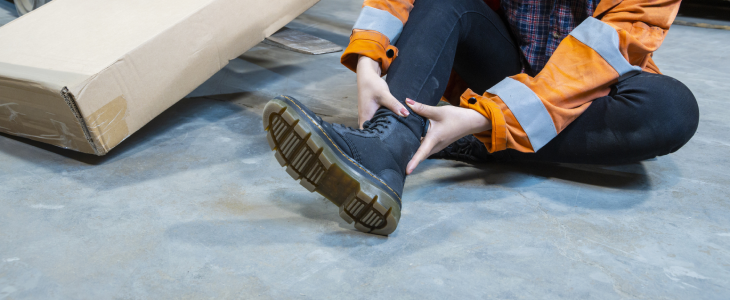Workplace safety is a critical concern for both employers and employees across North Dakota. Among the various injuries that can arise from occupational hazards, fractures can be particularly devastating, leading to prolonged recovery periods, lost productivity, and significant medical expenses.
Understanding Workplace Fractures
Fractures in the workplace can result from various incidents, including falls, machinery accidents, or repetitive stress injuries. These injuries may range from minor hairline fractures to severe compound fractures, each presenting its own set of challenges and recovery timelines. Due to the nature of their work environments, workers in industries such as construction, manufacturing, and agriculture are particularly susceptible to fracture-related injuries, but fractures can also easily happen in food service, retail, and other industries.
Safety Measures to Prevent Fractures
Implementing robust safety measures is critical to reducing the risk of workplace fractures. Some key strategies that employers and employees can adopt to create a safer work environment and minimize the occurrence of these potentially debilitating injuries include:
- Providing Comprehensive Training Programs for Workers—Employees should receive regular training on safety protocols and proper equipment use. This ensures they are aware of potential hazards and know how to avoid them. Training should also include emergency response procedures and hazard recognition, empowering employees to identify and mitigate risks before they lead to injuries, including fractures.
- Making Ergonomic Improvements in Work Settings – Adjusting workstations, tools, and equipment to fit workers’ needs can reduce strain and prevent musculoskeletal injuries like fractures. Ergonomic solutions can include adjustable chairs, footrests, and keyboard trays, as well as specialized tools designed to minimize force and repetitive motion.
- Implementing Fall Prevention Strategies – Installing guardrails, using safety nets, and ensuring proper ladder use can significantly reduce fall-related fractures. Additionally, keeping walkways clear of clutter and using non-slip flooring materials can help prevent slips and trips that lead to broken bones.
- Providing Personal Protective Equipment (PPE) – Gear like helmets, gloves, and knee pads should be readily available and properly fitted to protect workers from fractures and other injuries. Employers must also regularly inspect and replace PPE to ensure its effectiveness.
- Regularly Maintaining Equipment and Machinery – Routine inspections and maintenance prevent malfunctions that could lead to injury accidents. Implementing a scheduled maintenance plan helps identify wear and tear before it becomes a safety hazard.
- Ensuring Adequate Lighting in and Around Work Areas – Proper illumination reduces the risk of slips, trips, and falls by improving visibility and highlighting potential hazards. Adequate lighting should be provided in hallways, stairwells, and workstations to ensure employees can navigate their environment safely.
Occupational Safety Regulations
In North Dakota, workplace safety is governed by both federal and state regulations. The Occupational Safety and Health Administration (OSHA) sets federal standards, while the North Dakota Department of Labor and state law provide additional guidance and oversight.
OSHA requires employers to maintain a workplace free from recognized hazards that could cause serious harm or death. In practice, this means employers must continually assess their work environment for potential risks, implement appropriate safety measures, and promptly address hazards. Even if a specific OSHA standard doesn’t exist for a particular hazard, employers can still be cited if they fail to protect workers from known dangers.
The agency also mandates specific fall protection measures for work performed at heights. These standards require guardrails, safety nets, or personal fall arrest systems. Employers must also provide fall protection training, ensure proper equipment maintenance, and develop a written fall protection plan for certain high-risk activities.
When Accidents Happen
Despite best efforts, accidents can still occur. If you suffer a broken bone while working in North Dakota, it’s essential to:
- Seek immediate medical attention
- Report the injury to your employer as soon as possible
- Document the incident thoroughly
- Consult an experienced personal injury attorney
Contact Pringle & Herigstad, P.C., About Your North Dakota Workplace Injury Claim
Preventing workplace fractures requires a multifaceted approach combining robust safety measures, adherence to regulations, and a strong safety culture. By prioritizing these elements, employers can create safer work environments, and employees can reduce their risk of injury. Remember, a safe workplace is not just a legal requirement—it’s a fundamental right for every worker in North Dakota.
The lawyers at Pringle & Herigstad, P.C., have over a century of experience helping North Dakota workers through complex workplace injury claims. Our team is dedicated to helping you get the benefits, compensation, and support you deserve following a workplace accident. Contact us today.
Pringle & Herigstad, P.C. is committed to supporting individuals in North Dakota, including Grand Forks, Minot, Fargo, Bismarck, Williston, Rugby, Devils Lake, Jamestown, and the surrounding areas. Our dedicated team is here to provide legal assistance and guidance to those facing the complex challenges that arise from these incidents.
